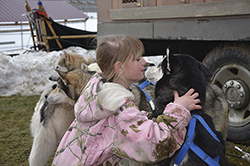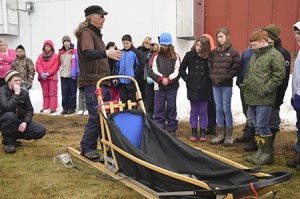

copyright the Chronicle March 18, 2015
by Nathalie Gagnon-Joseph
ALBANY — Albany Community School teachers had a stroke of genius when they decided on a dog-based teaching unit this winter.
“It really energizes the students, even my students that are the most difficult to get to want to read and write are focused and are interested and have questions and have stories,” said teacher Jennifer Schoen.
Students got a taste of the wild when Ken Haggett of Peace Pups Dogsledding brought his sled dogs for a meet and greet and sled ride on Wednesday, March 11.
“This last month we have been working on a dog unit starting with asking questions about how dogs became domesticated, choosing personal books to read about dogs, and finally reading Call of the Wild with the sixth- through eighth-graders, and Gary Paulsen’s My Life in Dog Years with the fifth-graders,” Ms. Schoen, said.
With the help of two grants — $400 from the Children’s Literacy Foundation as part of the Year of the Book, and $270 from the school’s parent-teacher-community group — the school was able to invite Mr. Haggett to introduce his dogs to the kids and talk about them.

He brought 20 dogs to the school in a custom carrier he built himself, but he owns 28 in total. All of them were Siberian huskies and ranged from one and a half to 12 years old. Mr. Haggett’s presentation was regularly interrupted by the dogs howling greetings to any newcomers.
Once one dog started, they all joined in, which set the students laughing. Mr. Haggett managed to interrupt the barking with a “Quiet!” or a “Quit it!”
Some of the children knew they would be meeting the dogs weeks ahead of time.
“I read more about them to see how it’s going to be to ride in the dogsled,” Austin Smith, 12, said.
Mr. Haggett explained that the sleds he brought weren’t all that different from those that would be used in the Iditarod, a 1,000-mile race in Alaska that the kids have been following.
“One of the things I really like about dogsledding is I can make a lot of my own equipment,” Mr. Haggett said after Principal Todd Rivver told students that Mr. Haggett had built the sled himself. “I have a small shop at the house, and I’ve been a woodworker most of my life.”
The dogsled was a toboggan-style sled with a plastic floor attached to runners. The gang line connected all the dogs to the sled and each dog had a tug line and a neck line.
Tug lines were attached to tug loops, which were part of the dogs’ harnesses, near the tail, and the neck lines were attached to their collars to help them maintain their positions.
The dogsleds were equipped with two different types of brakes, one to control speed, and one for steep inclines.

They also had sled bags to help people keep warm and dry or to carry equipment. Mr. Haggett allows up to 350 pounds worth of people in a sled, so two adults or one adult and two children.
Mr. Haggett has driven dogsleds for the past 14 years, mainly doing tours rather than racing.
“They have to like to pull and like to run and work together as a team,” he said about his dogs.
In Albany, Mr. Haggett and his assistant used two sleds attached to a seven-dog team each. Usually he uses eight-dog teams for tours, sometimes ten if the trail is soft or if the sled is heavy, he said.
In races like the Iditarod, there can be up to 16 dogs on a team. In that case the lead dogs are very far away from the driver.
“All you have for control back here is verbal over those front dogs,” Mr. Haggett said.
“Gee” means right, “Haw” means left, and “All right” gets them going.
“They’re smart dogs,” Mr. Haggett said.
Eleven-year-old Buck, short for Buckwheat, is his lead dog. Buck was something of a celebrity with the kids who had been reading Call of the Wild, according to Ms. Schoen, because Buck is also the name of the book’s canine protagonist.
“Call of the Wild was a stretch for our students, but it’s such a great book and even if they don’t understand all the words, they really seem to be enjoying it and they are talking about it,” Ms. Schoen said.
The dog-themed curriculum was Ms. Schoen’s idea, and her connections made it possible.

“I just love dogs and I’ve always loved dog sledding,” she said. “There are some great dog stories out there.”
She got her dog, Dragon, from one of Mr. Haggett’s workers, who had her own dog team. Dragon’s height made his gait different enough that he couldn’t run well with the others.
“Getting a good winter unit of study that the kids are interested in that ties all these themes together … it was our teachers, they just spend a lot of time,” Mr. Rivver said when asked how the project came together. “It’s the creativity of our teachers, and hard work. This took a ton of work.”
Besides building the curriculum, choosing books, and getting the dogs and Mr. Haggett to visit, the school had to ask trail groomers to create a route on school grounds. They came three times to pack the snow down enough for the dogs to run on, said Mr. Rivver, and all at no cost.
Thirteen-year-old Allison Powell was one of the students who read Call of the Wild.
“We’re researching the Iditarod, so keeping up with people and the dogs, and we’re voting on who we think should win,” she said. “I’ve been really excited. I’ve been looking at dogs, doing a lot of looking up about them.”
One of her favorite dogs was Koda, a needy three-year-old husky who actively called children back to pet him when they tried to move on to another dog.
Koda seemed particularly taken with nine-year-old Nevaeh Maskell, who stayed with him as long as she could.
While she didn’t get to ride in the sled, her face lit up with a huge smile at the mere mention of the dogs. “I like Koda,” she said.
Her fourth-grade class read Silver, by Gloria Whelan.
“It’s a really good book,” Nevaeh said. “It’s about this dog, they race and this dog wins but her sister dies. I learned about husky dogs, that it’s normal for some dogs to have different colored eyes.”
The rides cost $5 per student, $50 for the extra sled, and $100 for the presentation.
“It’s a lot of money to get a musher here so we’re so lucky that we got the grant,” Ms. Schoen said.
The main reason why some kids didn’t get to ride was because of the dogs’ energy levels.
“This is going to be enough for them,” said Ms. Schoen. “They would have to come on a different day to do it.”
Humans enjoyed the sunny, relatively warm weather, but it presented some hardships for the dogs. The snow was sticky, which slowed down the sled, and the warmth wore the dogs out.
Many of them were eating snow out of thirst, a practice called “dipping,” according to Mr. Haggett, and a few dug a small hollow in the snow to roll around in and cool off.
“I don’t run them unless it’s below 60 because they have a double coat,” Mr. Haggett said.
Twice a year Siberian huskies lose and regrow the undercoat that helps them withstand harsh winter weather.
That means they get the summer off or they’ll overheat. After winter, they don’t start pulling anything again until the fall, when Mr. Haggett gets them back into shape by pulling carts, he said.
At home by Lake Elmore, Mr. Haggett has a one-acre dog yard surrounded by seven-foot fences where most of the dogs live year-round.
“When it’s cold they burn a lot of calories just staying warm,” he said. “Most of these guys live outside. They have doghouses they sleep in at night.”
Mr. Haggett gives them a very high calorie diet to keep them healthy. He feeds them Inukshuk, a dog food that contains 32 percent fat and 32 percent protein, in the evening, and meat stew in the morning, in between rides, and mixed into their dry dog food.
“People give meat when they clean out their freezer,” he said.
During their visit to the school the dogs ate moose stew. Mr. Haggett cooked the meat overnight on a woodstove and added it to water to make the soup.
In the summer all 28 dogs play outside in the yard. Mr. Haggett relaxes with them, but he doesn’t tolerate fights or disagreements.
“Usually when I jump up and yell ‘Knock it off,’ before I get anywhere near them they disperse.
“I’ve never had a fight in the yard that’s resulted in a trip to the vet,” he said.
Mr. Haggett started with four dogs. He tries to adopt as much as possible since there are so many pups that need homes, he said.
He did have two litters of puppies however, one last year, and one 11 years ago. Buck was part of the first litter.
contact Nathalie Gagnon-Joseph at [email protected]
For more free articles from the Chronicle like this one, see our Featuring pages. For all the Chronicle’s stories, subscribe:
Print subscription
Annual online subscription
Short-term online subscription







